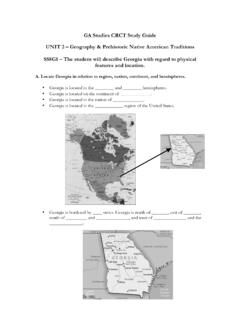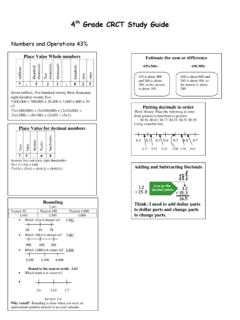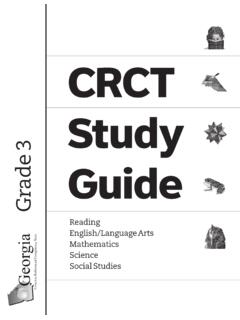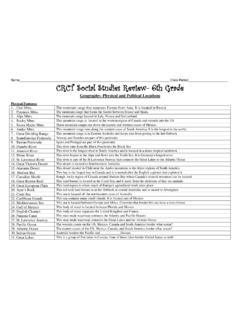Transcription of CRCT Study Guide - Middle School Mathematics …
1 CRCTS tudyGuideReadingEnglish/Language ArtsMathematicsScienceSocial StudiesGeorgiaCriterion-Referenced Competency TestsGrade 72703922-WUpdated September 2013 Copyright 2013 by Georgia Department of rights 42 of 111 Chapter 3By the end of Grade 7, students will understand how to apply and extend previous understandings of operations with fractions to add, subtract, multiply, and divide rational numbers; solve real-life and mathematical problems using numerical and algebraic expressions and equations; use properties of operations to generate equivalent expressions; draw, construct, and describe geometrical figures and describe the relationships between them. Solve real-life and mathematical problems involving angle measure, area, surface area, and volume; use random sampling to draw inferences about a population. Draw informal comparative inferences about two populations. Investigate chance processes and develop, use, and evaluate probability Mathematics activities focus on some of the concepts that are assessed on the Grade 7 CRCT Mathematics domains.
2 These domains are as follows:n Number and Operationso Geometry p Algebraq Data Analysis and ProbabilityThe Standards for Mathematical Practices are integrated across the four Practices are listed with each grade s mathematical content standards to reflect the need to connect the mathematical practices to mathematical content in Standards for Mathematical Practice describe varieties of expertise that Mathematics educators at all levels should seek to develop in their students. These practices rest on important processes and proficiencies with longstanding importance in Mathematics education. The first of these are the NCTM process standards of problem solving, reasoning and proof, communication, representation, and connections. The second are the strands of mathematical proficiency specified in the National Research Council s report Adding It Up: adaptive reasoning, strategic competence, conceptual understanding Mathematics Copyright 2013 by Georgia Department of rights 43 of 111 Chapter Three Mathematics (comprehension of mathematical concepts, operations, and relations), procedural fluency (skill in carrying out procedures flexibly, accurately, efficiently, and appropriately), and productive disposition (habitual inclination to see Mathematics as sensible, useful, and worthwhile, coupled with a belief in diligence and one s own efficacy).
3 Copyright 2013 by Georgia Department of rights 44 of 111 Chapter ThreeMathematicsn Number and OperationsCommon Core Georgia Performance Standards , , , and the Number and Operations domain, students apply and extend previous understandings of operations with fractions to add, subtract, multiply, and divide rational numbers and solve real-life and mathematical problems using numerical and algebraic expressions and equations. Students will use the commutative, associative, and distributive properties to simplify and solve expressions. Review the commutative, associative, and distributive properties. Commutative Change the order, , 5 9 6 5 6 9 Associative Change the grouping, , (5 9) 6 5 (9 6)Distributive Distribute a common factor, , (5 9) (5 6) 5(9 6) Give students expressions such as the ones below and challenge them to use at least one of the properties to make the expression easier to solve. 4 (Could use commutative to change to 4 so multiplying 6 instead of 4.)
4 ( ) 5 (Could use associative to change to ( 5) so multiplying 3 instead of 5.) ( ) ( ) (Could use distributive to change to ( ) so multiplying 9 instead of doing two multiple digit multiplications to get ) Discuss as a class how using the properties of operations made the expressions easier to solve. Students will use a number line to understand subtraction as the additive inverse and to find the distance between two rational numbers. Give each student a number line from 10 to 10 and a set of small counters such as beans. 10 9 8 7 6 5 4 3 2 1 012345678910 Use the problem 3 ( 4) as example and show that subtracting 4 isthe same as adding its opposite; 4. Have the students follow along by placing a bean on 3 and then deciding which way to move (subtract sign Activities Copyright 2013 by Georgia Department of rights 45 of 111 Chapter Three Mathematicshas you move to the left on the number line, but the negative in front of the 4 has you switch directions again to the right so it is the same as adding 4 to 3).
5 Have the students use this technique to solve problems such as the following by rewriting the problem as the additive inverse and then solving. 5 ( 1) 6 38 9 2 ( 7) Next, show that the absolute value of the difference between the two numbers is the same as the distance between them on the number line. Give the students two different numbers, such as 6 and 2, and have them place a counter on each number. Have them count the number of spaces between the two numbers (8) and then subtract the two numbers 6 2 8 and find the absolute value (8). Have them repeat this process with other number pairs. Solving two-step equations can be used to convert fictional temperature units to Fahrenheit to decide when seasons occur on a different planet. Euler is a planet in the Alpha Centauri system where the seasons and months have the same names as ours, but the seasons do not occur inthe same months. In addition, temperatures are measured using a unit called a Galois.
6 The equation that can be used to convert temperatures in Galois (G) to temperatures in Fahrenheit (F) is: G 194 The temperature on Euler was measured on one day in each month and is given in the table this On Euler it So in Fahrenheit it 323 GFebruary 350 GMarch 360 GApril 325 GMay 30 GJune 3 60 GJuly 3 120 GAugust 3 143 GSeptember 3 120 G Copyright 2013 by Georgia Department of rights 46 of 111 Chapter ThreeMathematicsOn this On Euler it So in Fahrenheit it 3 100 GNovember 3 75 GDecember 3 4 G On Euler, in which months do winter, spring, summer, and fall occur? To practice ordering rational numbers, students will order the value of several stocks after the first day of trading on the fictional Park City Stock Exchange (PCSE). The stocks all start the day at the same price ( Middle column), and the price changes over the course of the day are given in the right column: Start Price and Total Change of Stocks on the PCSES tock Start Price Change ($)Jet Oil Co.
7 $10 Electric, Inc.$10 2 14 Loose Leaf Book Publishers$10 1 19 Pinnacle Electronics$10 1 110 Pink Advertising$10 2 16 Java Roasters$10 110 Old Thyme Spices$10 Software$10 Mattress Co.$10 1 111 Shred Skis$10 listing the stocks in order from highest price to lowest price at the end of the first day of trading, students answer these questions: How did you order the numbers given in different forms? Did you find the actual price at the end of the day or just use the price increases given in the right column? If you used only the price increases, why didn t you think it was necessary to find the actual prices? Which stock fell more, Millennium Software or Comfy Mattress how much? Write your answer in decimal form. What is the difference between the new values of Atlantic Electric, Inc. and Pinnacle Electronics? Write your answer in fraction form. Copyright 2013 by Georgia Department of rights 47 of 111 Chapter Three Mathematicso GeometryCommon Core Georgia Performance Standards , , , , , and Within the Geometry domain, students will draw, construct, and describe geometrical figures and describe the relationships between them and solve real-life and mathematical problems involving angle measure, area, surface area, and following activities develop skills in this domain: To work with the radius and area of circles, students should explore the real-world situation illustrated by the diagram below.
8 A farmer buys a new system to water crops that uses a rotating steel arm, which sprays water over a circular area. The arm rotates around a center point of an existing square field. The arm will reach exactly to the edges of the square. The square field measures 100 feet along each edge. Students will answer the following questions: What is the length of the arm? What is the area watered by the system? What area of the square field will NOT be watered?r To establish the relationship between the circumference of a circle, its diameter, and pi, discuss the way a bicycle odometer works. Explain that a bicycle odometer measures how far a bike has traveled by counting how many times the wheel goes around. Thinking of the common measurements of a circle (radius, diameter, circumference), students will describe which measurement represents how far the bike has moved when the wheel has gone around exactly once. Since different bikes have different tire sizes, the odometer has to be set up for the proper tire size or its measurements will be wrong.
9 Discuss why this is the case. Next, give students a chart with columns for Diameter, Radius, Circumference, DiameterRadius , and CircumferenceDiameter . Studentswill fill out the chart for each of the following common diameters of bicycle tires: 16 in., 20 in., 24 in., 26 in., and 27 in. Students will describe what pattern they see when the diameter is divided by the radius. Repeat for the circumference divided by the Copyright 2013 by Georgia Department of rights 48 of 111 Chapter ThreeMathematics To work with measurements of circles, students should gather circumference measurements of common objects using string. They will first brainstorm several circular objects in their surroundings for which they are able to measure circumference using string, such as a tire, lampshade, frying pan, clock, or trash can. Students will explain why it might be difficult to measure the radius or diameter of an object ( , hard to pinpoint the center, cannot measure inside a solid, etc.)
10 Give students expressions they can use to find the diameter and radius once they have measured the circumference:d C , where d diameter, C circumference, and d 2, where r radius and d diameterStudents will substitute the values for C they measured and find the values for the diameter and radius. They should create a table to record the circumference, diameter, and radius of each object. Scale drawings are a geometric concept that links ratios and proportion with objects in the real world. An example of this can be found in scaled drawings of a Drawing511 Students should first find the corresponding sides in the two figures, then calculate the ratio of corresponding sides using given lengths. Finally, they should find any missing lengths of sides, using the ratio of corresponding sides for both figures. Copyright 2013 by Georgia Department of rights 49 of 111 Chapter Three Mathematicsp AlgebraCommon Core Georgia Performance Standards , , , , , and Algebra domain addresses students ability to use properties of operations to generate equivalent expressions and solve real-life and mathematical problems using numerical and algebraic expressions and following activities develop skills in this domain: To use variables for unknown quantities in algebraic expressions, students should explore real-life situations that can be expressed mathematically, for instance, the relative age of siblings.











